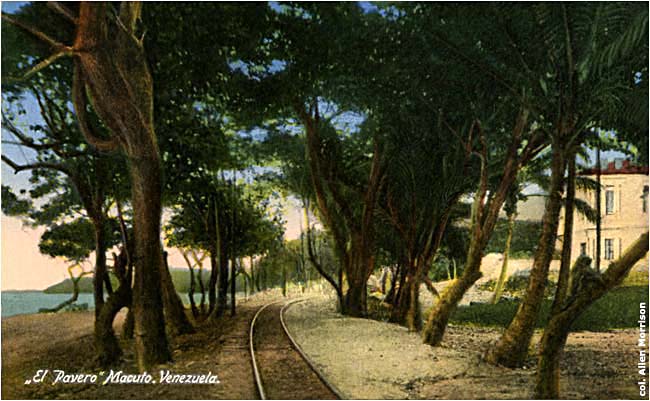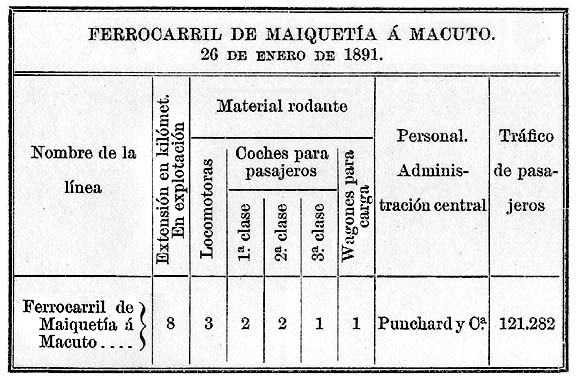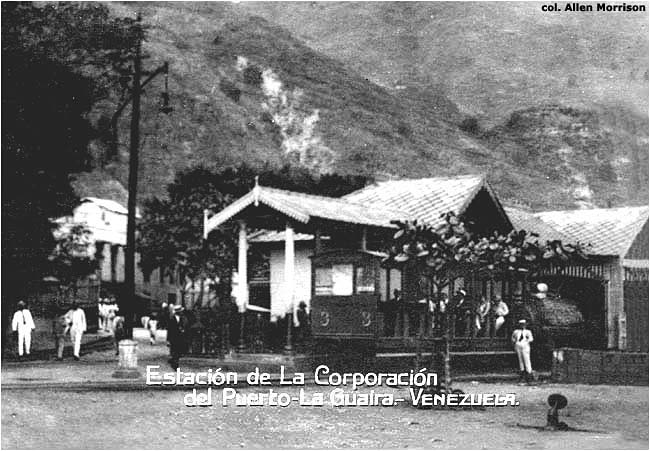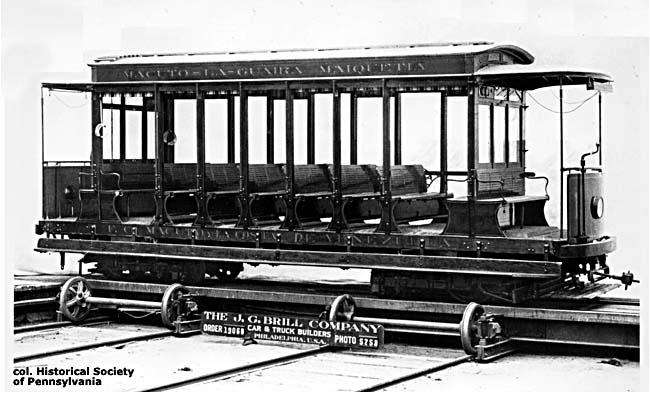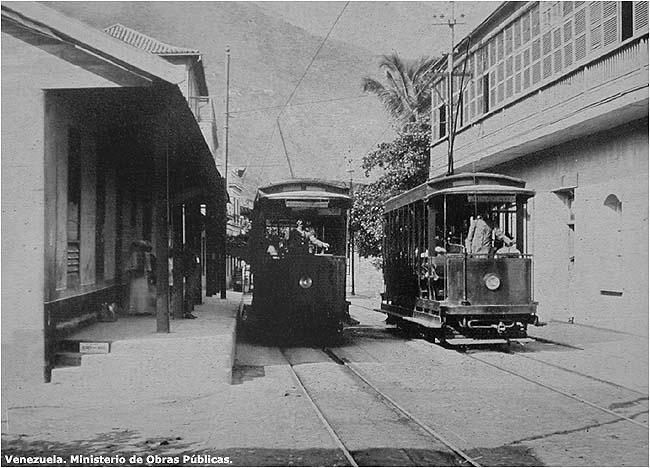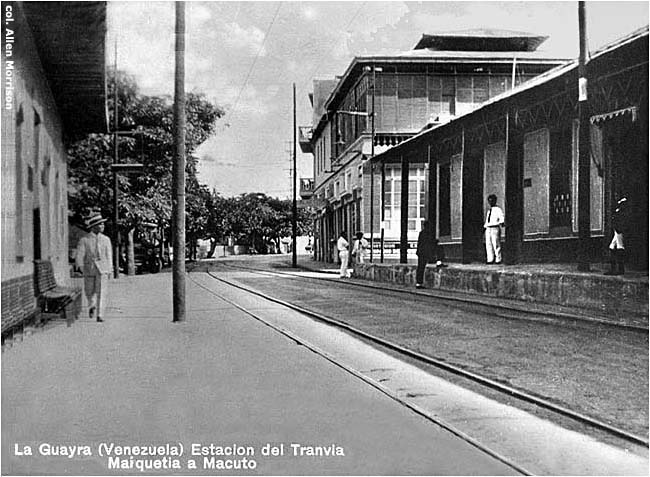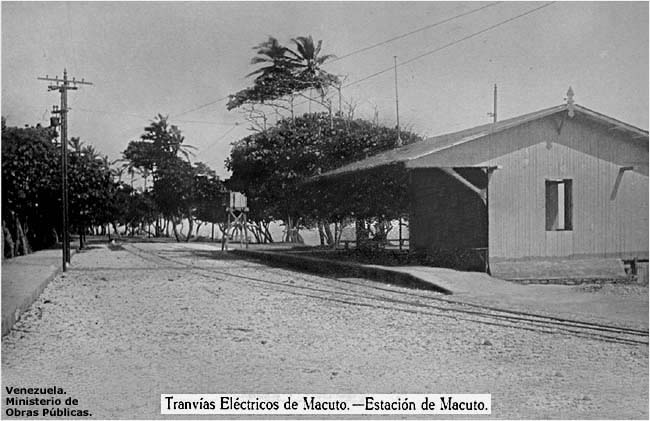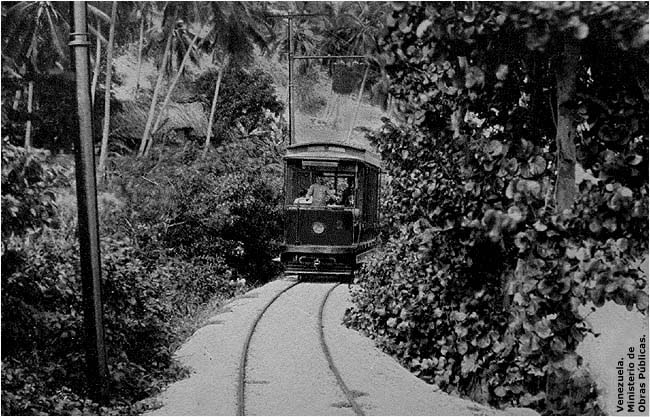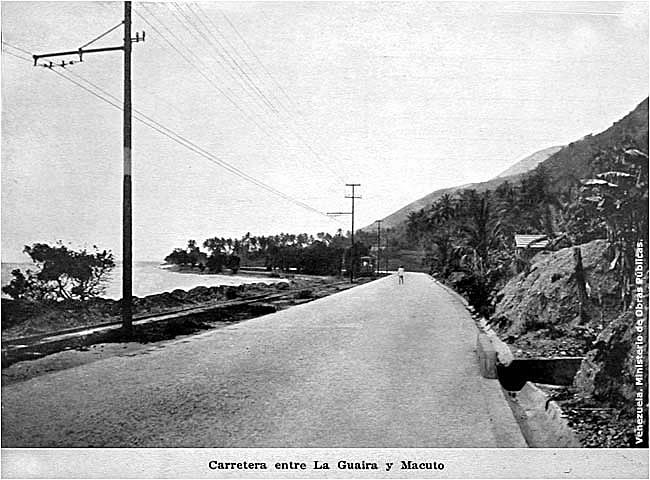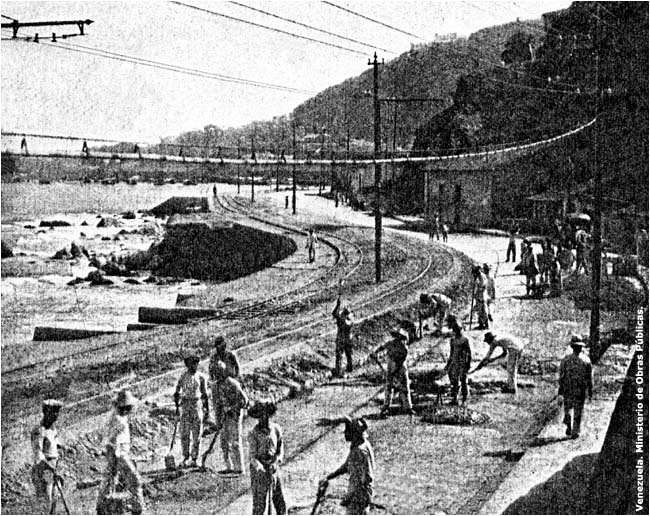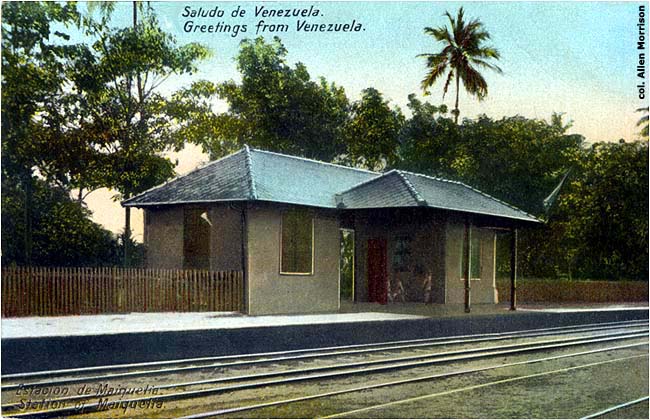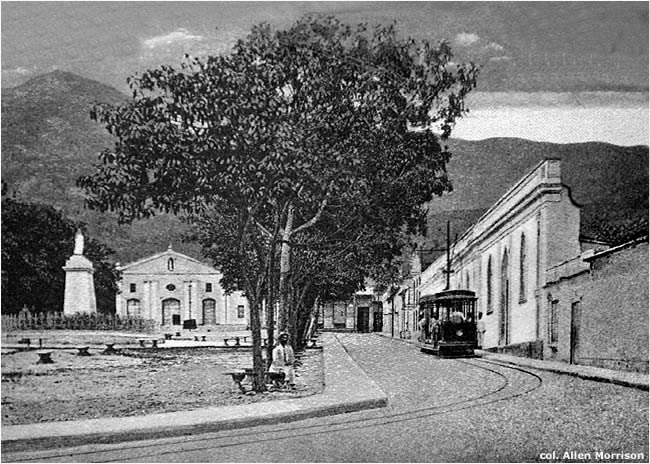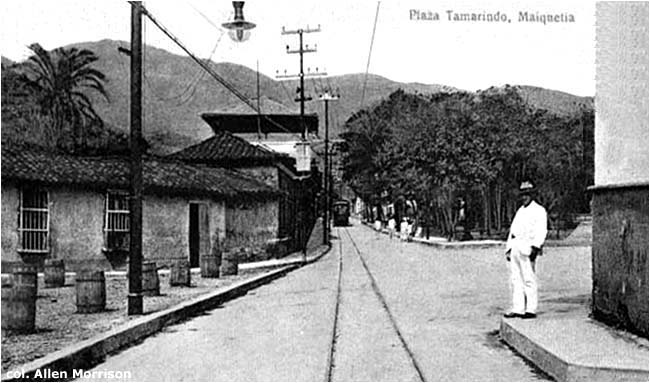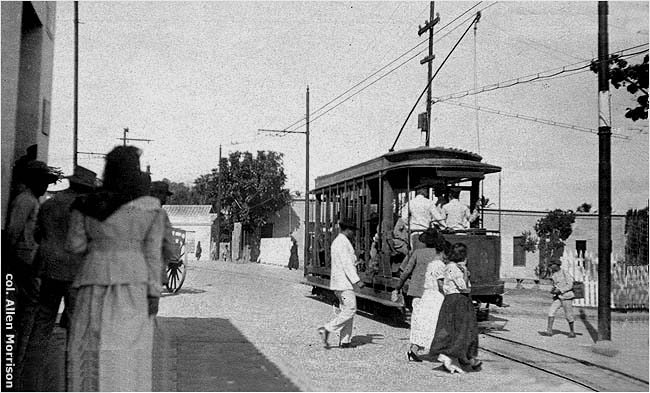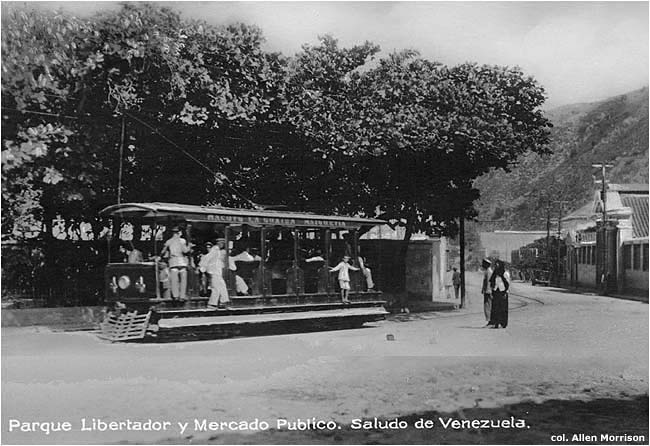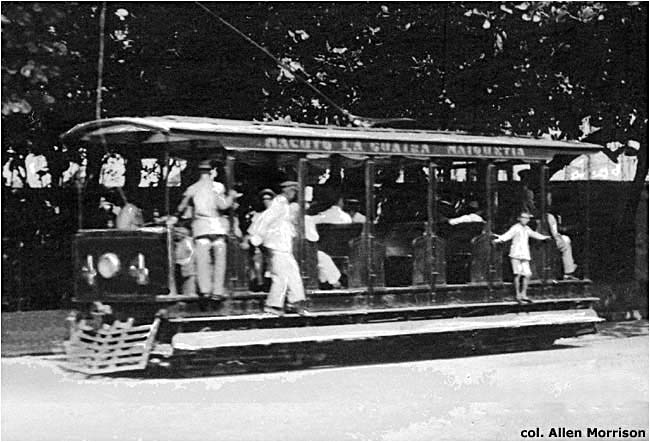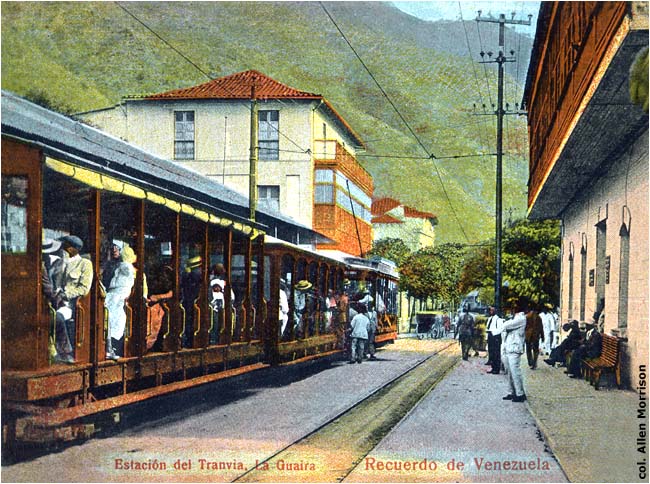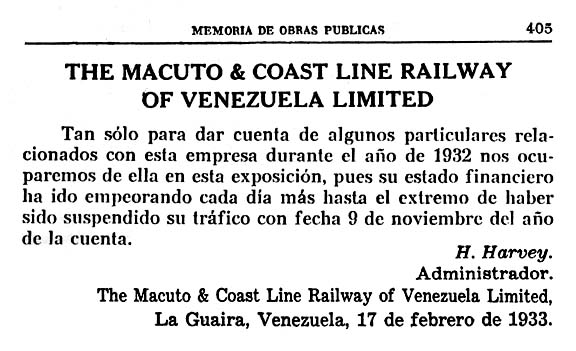Ferrocarril de Maiquetía a Macuto Macuto & Coast Line Railway of Venezuela The tramways of Macuto, La Guaira and Maiquetía VENEZUELA BY Allen Morrison
This page considers the little 8 km railway that operated for 48 years between Maiquetía, La Guaira and Macuto on Venezuela's north coast [see satellite view]. It should not be confused with the much longer Ferrocarril La Guaira y Caracas, which connected the seaport with the capital. Macuto is one of Venezuela's principal vacation centers. La Guaira is its chief port. Maiquetía occupies the largest level area in the region and is the location today of Simón Bolívar International Airport. The inauguration of the Ferrocarril La Guaira y Caracas in 1883 inspired numerous other projects, including the development of the waterfront and harbor and the construction of another railway – a sort of extension of the FLGyC – east along the coast to Macuto [see map]. According to the 1884 Memoria of Venezuela's Ministerio de Obras Públicas, the Ferrocarril de Maiquetía a Macuto received permission to build on 24 November 1883. The line is said to have begun carrying passengers in 1884, but the exact date could not be found and the line's history is obscure. A synopsis published by the U.S. Dept. of Commerce in 1927 [see BIBLIOGRAPHY] says that the Venezuelan government built the line, then transferred it to a Venezuelan firm, which sold it to a French company, which was acquired by La Guaira Harbour Corporation, which was the British organization that built and operated the docks. One of the directors of the French company was a macuteño named Juan Bautista Matharan, and the line was sometimes called Ferrocarril (or Tranvía) Matharan. The original railway ran from the Macuto River in Macuto to the FLGyC station in Maiquetía, and paralleled the FLGyC at its western end [see map]. Track gauge of both railways was 36 in/914 mm. The chart below was published by the Ministerio de Obras Públicas in its Memoria of 1891 [see BIBLIOGRAPHY]. The three steam locomotives were leased from La Guaira Harbour Corporation:
The postcard view below, from about 1900, shows a passenger car and steam locomotive at the Aduana station of the Harbour Corporation (Corporación del Puerto) in La Guaira [see map]. This is presumably an FMM train headed for Macuto. It is the only illustration that the author could find that showed steam operation on the line [col. AM]:
La Guaira Harbour Corp. purchased the Ferrocarril de Maiquetía a Macuto in 1912 and operated it as the Macuto & Coast Line Railway of Venezuela for the next 20 years. M&CLRV electrified the line in 1913 and purchased two 4-axle 10-bench open trams from J. G. Brill Co. in Philadelphia, USA. Electrical equipment and maximum-traction trucks came from Dick, Kerr & Co. in Preston, England. The photograph below shows tram #1 at the Brill factory in 1913. The lower inscription reads "F. C. MACUTO Y LA COSTA DE VENEZUELA" – even though Venezuelan documents always referred to the company by its English name [col. Historical Society of Pennsylvania]:
The new electric railway began carrying passengers on 9 May 1914. Here are trams 2 and 1 at the Plaza Vargas station in La Guaira [see map]. View is south, looking toward the mountains [Ministerio de Obras Públicas, Revista Técnica, 8/1914, p. 344]:
Another view of the same station, but looking north [see map]. The line veers east in the distance toward Macuto [col. AM]:
Except for the overhead wires, the terminus of the electric tramway in Macuto was probably little changed from the steam days [see map]. A more imaginative photographer would have waited until a tram arrived at the station [Ministerio de Obras Públicas, Revista Técnica, 8/1914]:
Tram 2 passes through dense brush at El Pavero, just west of Macuto [see map]. This may be the same place shown in the color view at the top of this page [Ministerio de Obras Públicas, Revista Técnica, 8/1914]:
Most of the route between Macuto and La Guaira was alongside the coastal highway, next to the Caribbean Sea [see map]. Note tram in the distance. It must have been a pleasant ride [Ministerio de Obras Públicas, Revista Técnica, 8/1914]:
In 1916 M&CLRV purchased another 10-bench tram from Brill which was numbered 3. Dick, Kerr & Co. again supplied electric equipment and trucks, which this time were conventional equal-wheel models (not the maximum-traction type as on cars 1 and 2). In 1920 M&CLRV and Ferrocarril La Guaira y Caracas relaid their rails along the bay between La Guaira and Maiquetía [see map]. Both companies used the same 36 in/914 mm track gauge, but there was no physical connection. Note wire over the tramway track on the right. FLGyC will hang wire over its rails, too, when it electrifies in 1928 [Ministerio de Obras Públicas, Memoria 1921, v. 1]:
Until 1922 the western terminus of the tramway (and also of the earlier steam line) was at the FLGyC station in Maiquetía [see map]. In the postcard view below the two pairs of rails in the foreground belonged to the tramway. Either (1) the postcard publisher "improved" his image by erasing the overhead wires or (2) the picture was taken before the line was electrified [col. AM]:
In 1922 the tramway was extended from Los Pipotes down Calle Real to Plaza Lourdes in Maiquetía [see map]. It is not known if the branch to the FLGyC station remained. Here is the new terminus of the M&CLRV on the square in front of San Sebastián Church [postcard, col. AM]:
On Calle Real, a few blocks east of the church, the line passed the wooded Plaza Tamarindo, today called Plaza de los Maestros [see map]. The view is southwest [postcard, col. AM]:
Someone scribbled "Maiquetía 1925" on the back of the postcard below. The precise location is unknown. This is car 3, built in 1916 [col. AM]:
In 1924 Macuto & Coast Line Railway of Venezuela ordered another pair of bogie trucks and electrical equipment from English Electric Co. (ex-Dick, Kerr & Co.) and built its own electric tram from one of the passenger cars used on the earlier steam line, shown in the third illustration on this page. Here is M&CLRV tram 4 at Parque Libertador in La Guaira [see map]. The car is headed east, toward Macuto. The sea is visible behind the trees [postcard, col. AM]:
Enlargement of tram 4 shown on the postcard above [col. AM]:
M&CLRV also used four former steam coaches as trailers. The partly tinted postcard below shows two trailers attached to a Brill motor car at Plaza Vargas station – also shown in the fifth and sixth illustrations above. This "tram train" had arrived from Macuto and was headed for Maiquetía [see map]. The photographer was facing south [col. AM]:
According to a survey published by the U.S. Government in 1927 [see BIBLIOGRAPHY], M&CLRV's four electric trams and four trailers carried 1,728,736 passengers in 1925. An estimated 2.5 million passengers were carried in 1929, when M&CLRV ordered two more electric trams from English Electric – this time complete vehicles: bodies, electric equipment and maximum-traction trucks. The new cars were numbered 5 and 6. M&CLRV purchased two more similar trams from English Electric, numbered 7 and 8, in 1930. By the end of that year it had a fleet of eight passenger motor cars and four trailers. M&CLRV was the only tramway system in Venezuela that used 4-axle cars exclusively. (The Caracas and Maracaibo systems had a few 4-axle cars, but most of their trams were 2-axle models. Carúpano and Valencia had only 2-axle cars.) It was also the only system that used a track gauge of 36 in/914 mm. (The Caracas, Carúpano and Valencia tramways used 42 in/1067mm. Maracaibo used 30 in/762 mm.) The new investments were ill-timed. Gasoline was cheap, automobile and bus traffic was increasing, the Great Depression had begun, and the Venezuelan government wanted to nationalize the docks controlled by La Guaira Harbour Corporation, which owned the tramway company. Despite the addition of new equipment, M&CLRV's passenger flow fell from 1,646,676 in 1931 to 1,039,128 in 1932. There was a 37% reduction in revenue, M&CLRV could not pay its bills or employees, and the highway department wanted its right-of-way for a new road to Macuto. The tramway system closed on 9 November 1932. The following notice appeared in the 1933 Memoria of the Ministerio de Obras Públicas:
"If only to record a few details concerning this company during the year 1932 will we bother with this report, since its financial status has worsened each day to the point that operation was suspended on 9 November of that year [1932]." Some of the electric trams had run less than two years. All vehicles were apparently scrapped and the line was dismantled. It was the earliest closure of an electric tramway in Venezuela. (Both the Carúpano system and electric operation on the Ferrocarril Central in Caracas ended in 1933. The Maracaibo system closed in 1934. The Valencia system and the Caracas urban lines ran through the 1940s.) The Ferrocarril La Guaira y Caracas, which was electrified in 1928, continued operation until 1951.
BIBLIOGRAPHY Venezuela. Ministerio de Obras Públicas. Memoria. Caracas, 1884-. A chapter entitled "Ferrocarril de Maiquetía a Macuto" on pp. 266-267 of the 1885 edition reports that construction of the line has been completed – but does not say that it is in operation. "Documento Número 13" on pp. 222-223 of the 1891 edition includes the chart reproduced near the top of this page. United States. War Department. General Staff. Second (Military Information) Division. Map of La Guaira, Venezuela, scale: 1 inch = 100 yards. Washington, 1908. Large map shows railway detail, identifies buildings and names streets. Venezuela. Ministerio de Obras Públicas. Revista Técnica, 8/1914. Caracas, 1914. "The Macuto & Coast Line Railway of Venezuela Limited", pp. 344-347. Superb description of the new electric tramway, power plant and cars. Five large illustrations, two of them full-page. The same photographs are reproduced following p. 80 of the 1915 Memoria. "Macuto and Coast Line Railway (Venezuela) Electrification" in Electric Railway and Tramway Journal (London), 9 July 1915, pp. 17-18. Excellent article describes electrification of the line and the new electric rolling stock. Map and photograph of electric tram number 1. Venezuela. Ministerio de Obras Públicas. Memoria. News items and photographs of the M&CLRV in the 1921 and 1929 editions. Final report and announcement of closure in the 1933 edition, vol. 1, pp. 405-407. U.S. Department of Commerce, Bureau of Foreign & Domestic Commerce. Trade Promotion Series 39. Washington, 1927. The chapter "Macuto & Coast Line Railway (Ferrocarril de Maiquetía a Macuto)" on pp. 381-382 provides an excellent survey of the line. Eduardo Röhl. Plano de Caracas y sus alrededores, 1:30,000. Caracas, 1934. Map of the Caracas metropolitan area shows the railway between Maiquetía and Macuto. Venezuela. Ministerio de Obras Públicas. Servicio Aerofotográfico. La Guaira y Maiquetía. Caracas, 1936. Nice map at scale 1:10,000 shows the winding path of the Caracas railway in the Maiquetía area. The tramway is not shown for it had disappeared. Luis Enrique González F. La Guayra: Dos Siglos de Historia. Caracas, 1983. Useful tramway references. Alberto de Veer-Englert. Tarmas – y entonces – La Guayra. Caracas, 1989. Itinerary of the tramway route, p. 153. Luis Cordero Velásquez. La Venezuela del Viejo Ferrocarril. Caracas, 1990. Impressive, 40-chapter, 289-page illustrated survey of railway development, with unusual emphasis on tramways. "El Tranvía de La Guaira", p. 245. Zulay M. Rojo. El Puerto de La Guaira: Una inversión extranjera 1885-1937. Mérida (Venezuela), 2000. This history of La Guaira Harbour Corporation contains useful railway references.
See The La Guaira & Caracas Railway See The Trolleybuses of Mérida See my index of If you have comments, criticism or suggestions, This site was placed online on Copyright © 2007-2107 Allen Morrison |
